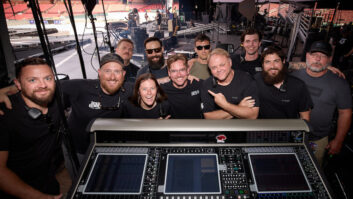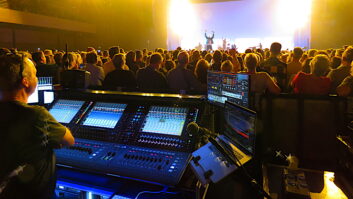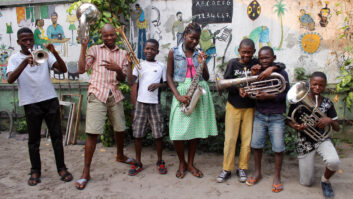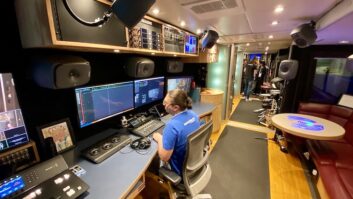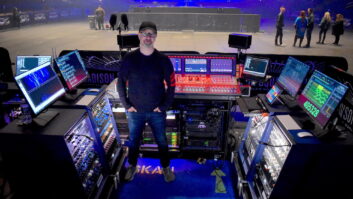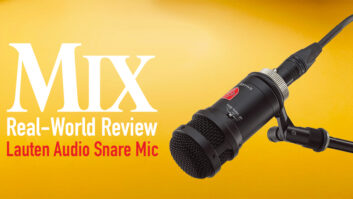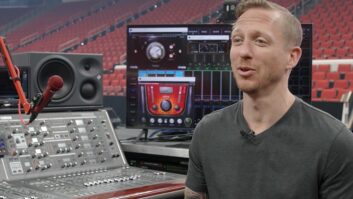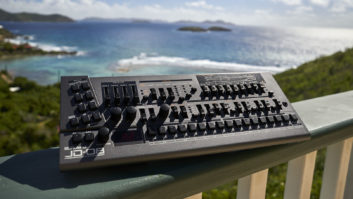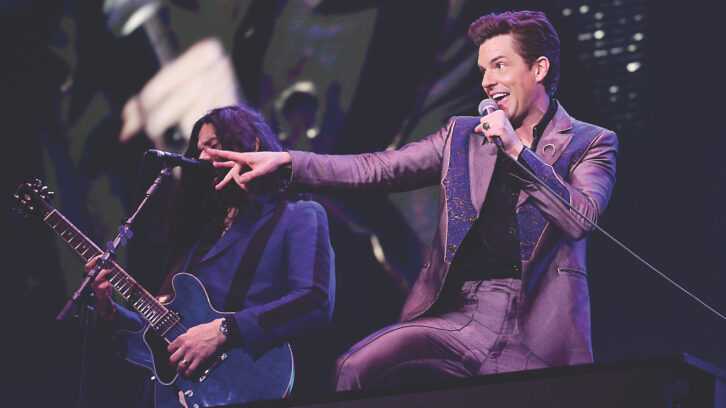
New York, NY (November 18, 2022)—Since The Killers began in 2001, the Las Vegas rock band has always offered up epic, soaring vocals with guitar lines to match, and in concert, they only take things higher. The group has proven that time and again throughout this year’s “Imploding The Mirage” world tour, which began with two months of rehearsal leading into a U.K. stadium concert tour in April and May, followed by a sprint through Europe’s summer festivals. North America got its own 30-date Killers spree from August through October, and this month sees the group strike South America before heading to Australia and New Zealand to close out the year.
Helping slay the audience every step of the way is veteran FOH engineer Kenny Kaiser, while engineer Marty Beath mixes wedges for singer Brandon Flowers, and Matt Breunig tackles in-ear monitor mixes for the other eight musicians onstage and the crew. While the tour’s live sound spec has remained the same worldwide, for North America, the audio team used concert sound gear provided by Delicate Productions (Camarillo, Calif.) to keep things rocking.
“We have three SSL L500 consoles out, all sharing stage racks,” said Kaiser. “We don’t have splits; we’re all sharing gains, which is kind of nice. I’ve been on SSLs for the better part of 10 years now. I was on it first, then we were doing a run and Marty was on another console at the time. He asked for recordings off my console for a day; I gave them to him and he called me back within 15 minutes going ‘Are these just your pres? That sounds amazing!’”
Kenny Chesney—Taking Here and Now to Another Level, Part 1
Kaiser tends to use onboard effects and a handful of his favorite outboard units, noting, “I don’t really use any plug-ins; as far as extra servers go, I absolutely despise it. I find it’s just a distraction. Does it sound great? I’m sure it does, but I think also sometimes it gets overused too much. Remember the old days with analog consoles? Growing up, working in clubs, you had an analog console, maybe four comps and four gates, and you had to figure it out. Then the digital console came along, and it’s ‘I could put a compressor on everything!’ Yeah, you can—but should you? That is the question.”
Outboard units in Kaiser’s racks range from the recent—a pair of Solid State Logic Fusion analog processors—to longstanding go-to gear like a pair of Bricasti M7 stereo reverbs, an Eventide Ultra-Harmonizer, an Empirical Labs Fatso EL7x and a Cedar DNS 8D. “The L500 can do all the stuff that I need to do; the choice to use this equipment is more that I’m used to it,” said Kaiser. “The Bricasti reverbs sound like Bricasti reverbs—amazing. Also, on many of the newer Killers songs, there’s a lot of chorus on some of the vocals, so I picked the Eventide because there’s some legendary choruses in there, and it’s easy to manipulate on the fly. I have the Cedar because I have nine vocal mics onstage, so it helps clean up noise off the mics.”
The most surprising piece of outboard gear, however, is Kaiser’s own personal Wendel Jr.—the 1980s drum sound replacement system invented by legendary recording engineer Roger Nichols. “I bought it used from a buddy of mine—Joel Lonky who mixes Billy Idol,” said Kaiser. “I saw it in his rack at a festival and he said he didn’t use it anymore; I went to the ATM onsite and bought it from him right there out of the rack!”
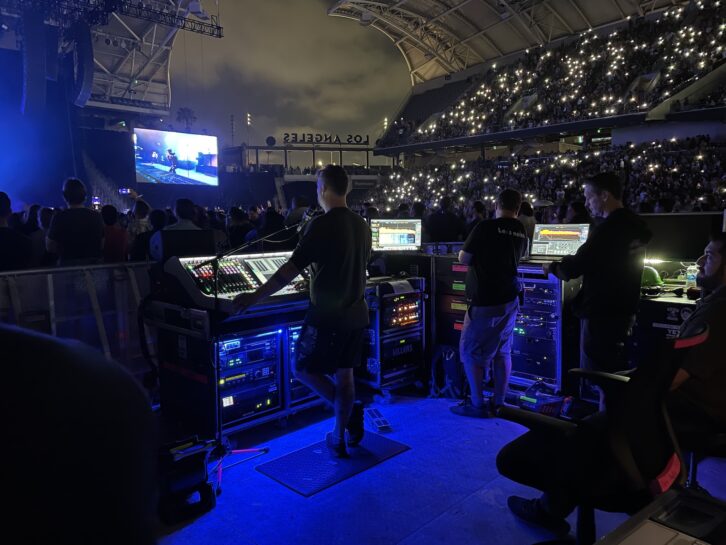
Connecting all that outboard gear to the console are three Focusrite RedNet units—a RedNet D16R AES/Dante interface and two RedNet A16R MkII analog/Dante interfaces. Kaiser explained, “I could use XLRs, patching them in the back of the console, and have a bunch of W1 multipin connectors going into the sled that are big, honky and a pain to connect all the time—and then the back of the console would look like a rat nest at the end of the tour. Now, literally the only thing coming out of the console is my power, my fibers to and from the stage, and another fiber connector that goes to my sled underneath, where I have a D16R handling AES for my reverbs, while the A16Rs are doing all my analog patches into the console.”
With all that firepower at his fingertips, Kaiser creates a mix that expands on the familiar album mixes. “The band in general want it to sound like the album—that’s the number-one rule—but at the same time, you want to have more of a live sound. In my mind, the drums have to be a little bit punchier and less buried than on some of their albums. That’s just me; it’s how I like to mix. Same thing with the guitars—they have to be a bit above everything that’s happening on stage…[but] you have to be true to the album.”
Up onstage, things are loud. All of The Killers wear in-ears except frontman Flowers, who hears everything via 10 d&b audiotechnik M2 wedges, three d&b V-Series boxes a side for sidefills and a few more Vs placed as needed. Guitar amps onstage provide some vibe for the musicians, but fortunately there’s no mics on them, as the inputs come from Fractal units. Drums, meanwhile, are captured by DPA mics, with 2011 twin diaphragm cardioids on the snares and hi-hat, and 4011A cardioid condensers on the toms and cymbals. Elsewhere onstage, DPA D:factos are used for backing vocals, while Flowers sticks with his trusty Shure Beta 58.
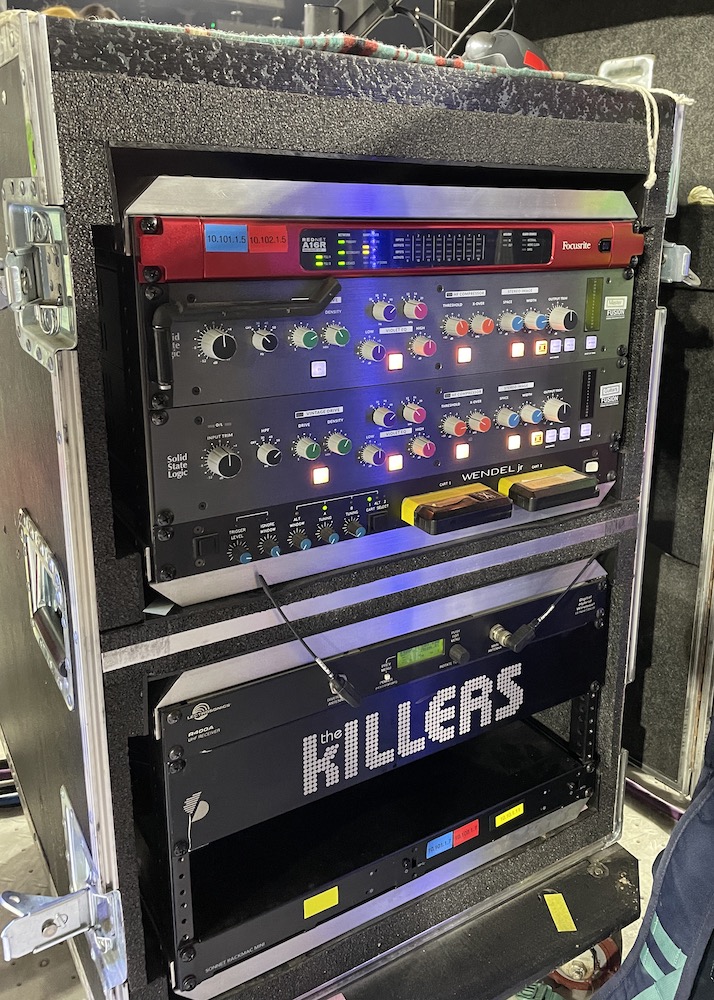
The d&b audiotechnik P.A. used for the North American leg came was provided by Nashville’s Spectrum Sound, with main hangs of GSL line array loudspeakers, KSL boxes used for 270-degree hangs, a phalanx of flown SL- SUBS and SL-GSUBs on the ground. “In Europe, we used Capital Sound for the d&b rig and were controlling the P.A. with some with some RedNet products, too,” Kaiser added. “We were doing Dante from the front of house to the deck to control the P.A.; over here, I spec’d the same thing, but they weren’t available so we’re using the d&b DS100 signal engine. There’s been a lot of RedNet on this tour—we also have X2Ps, that little two-channel Dante desktop interface, scattered around for artists to listen to stuff backstage off their computers. The tour is jam-packed with those things, and they’re great.”
Mixing stadiums and arenas around the world is a long way from Kaiser’s own musical beginnings, when he toured with his punk band Karate High School in the early 2000s. “I was mixing in San Francisco clubs and then started with a couple of local AV companies that did a lot of corporate work,” he recalled. “My band got signed and we played Warped Tour around 2003, but then I realized I was making more money doing sound at clubs and theaters than I was touring in my own band. I said I’m doing sound then, because at some point I gotta pay my bills.”
It was a good decision. Years later, with tenures mixing Train, Demi Lovato, Sammy Hagar and Selena Gomez to his credit, it’s kept him working steadily, and will continue to do so in 2023 when he holds down the Killers’ FOH fort for a second North American run in March.
